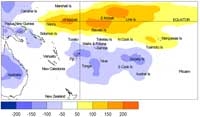


A review of Southwest Pacific climate in 2007
Dr. Jim Salinger, National Institute of Water and Atmospheric Research, New Zealand
Climate diagnostics for the South Pacific early in 2007 showed a change from an El Niño to a La Niña climate pattern (right). The first quarter of the year was influenced by decaying El Niño characteristics, followed by a neutral period. La Niña conditions in the tropical Pacific developed by September, and matured in December. ENSO-related influences on the location of the South Pacific Convergence Zone (SPCZ) caused it to be north of its normal location in the first part of the year, and further south than usual from July through December.
Sea surface temperatures (SSTs)
For 2007, above average SSTs occurred throughout much of the tropical Southwest Pacific to the south and west of the International Date Line, and were at least +1.5 ºC above average around the Solomon Islands, Vanuatu, Fiji, Samoa and Central French Polynesia. Below average SSTs existed in the equatorial region about and east of the Line Islands. Southwest Pacific island surface air temperature anomalies were generally consistent with the SST anomalies throughout the region. It was an extremely warm year in Fiji and Tonga where mean temperatures were about 1.0 ºC above historical averages. Above average equatorial SSTs occurred in January around Western and Eastern Kiribati (+1 ºC anomalies), however, the warm anomalies moved away from the Equator to affect regions in higher latitudes further south until October, dissipating after that. Negative SST anomalies (-0.5 ºC) became apparent east of the Date Line in July, gradually spreading west to reach the Date Line in October. SSTs cooled by -1.0 to 1.5 ºC below average in the seas around Eastern Kiribati for the rest of the year.
Outgoing Longwave Radiation (OLR)
January’s OLR anomalies showed enhanced convection over Kiribati southeast to the Northern Cook Islands, with suppressed convection further south, typical of an El Niño event. However, from June onwards a reversal to convection patterns associated with La Niña development occurred. Mean sea-level pressures were above average in the subtropics west of the Date Line until April. Negative anomalies developed in the tropical western Pacific between Papua New Guinea (PNG) and Fiji from June onwards. OLR anomalies showed a region of enhanced convection over PNG, Fiji, and Central French Polynesia. Suppressed convection persisted over Kiribati, extending to Northern French Polynesia. 2007 rainfall anomalies were similar to the OLR pattern, with above average rainfall between Fiji and Central French Polynesia, including Tonga, and below average rainfall in Kiribati, extending to Northern French Polynesia.
